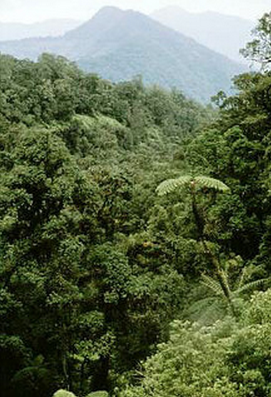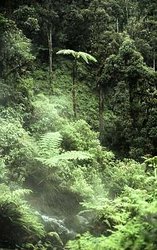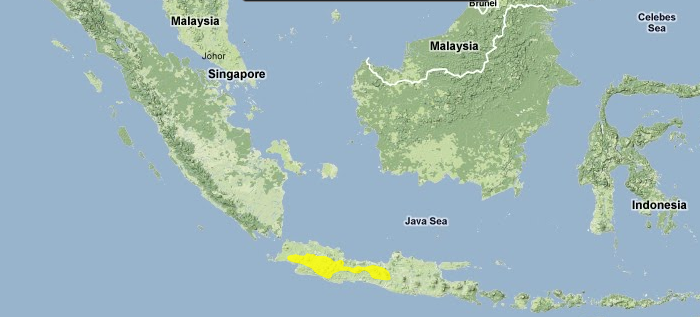Western Java montane rain forests

Western Java, Indonesia (Photograph by © WWF-Canon/Tom MOSS)
The Western Java Montane Rain Forests are found on one of the most actively volcanic islands in the world. Several mammals and nine bird species are found nowhere else on Earth. Once the home of the extinct Javan tiger (Panthera tigris sundaicus), only a fifth of the original habitat remains in this ecoregion, and these forests are scattered in fragments throughout the mountains.
Location and General Description
This ecoregion represents the montane forests of west Java. Based on the Köppen climate zone system, this ecoregion falls in the tropical wet climate zone. Java probably did not exist before the Miocene (24 m.y.).
Truly born of fire, the island of Java is the result of the subduction and remelting of the Australian-Indian Ocean tectonic plate beneath the Eurasian tectonic plate at the Java trench. The melted crust has risen as volcanoes and, along with subsequent sedimentation, created Java. Therefore, the surface geology consists of Tertiary and Quaternary volcanics, alluvial sediments, and areas of uplifted coral limestone. Twenty of the volcanoes on Java and Bali have been active in historic times, and they are among the most active volcanic islands in the world. During previous ice ages, when sea levels were much lower, Java was connected to Sumatra, Borneo, and the rest of the Asian mainland.
The main forest types in this ecoregion are evergreen rain forest, semi-evergreen rain forest, and aseasonal montane forest. The evergreen and semi-evergreen rain forests generally are found in the lower portions of the ecoregion. Evergreen rain forests of Java contain Artocarpus elasticus (Moraceae), Dysoxylum caulostachyum (Meliaceae), langsat Lansium domesticum (Meliaceae), and Planchonia valida (Lecythidaceae). Semi-evergreen rain forest differs from evergreen rain forest by being slightly more seasonal, with two to four dry months each year.
The transition between lowland and montane forests is a floristic one, and some plant families and genera are found only on one or the other side of this transition. Above 1,000 meters (m), genera begin to include Anemone, Aster, Berberis, Galium, Gaultheria, Lonicera, Primula, Ranunculus, Rhododendron, Veronica, and Viola. Some lowland tree species transition out up to 1,200 m. The most abundant montane tree species in the lower montane zone are Lithocarpus, Quercus, Castanopsis, and laurels (Fagaceae and Lauraceae). Magnoliaceae, Hamamelidaceae, and Pococarpaceae are also well represented. Few emergents, primarily Atingia excelsa and Podocarpus spp., are found in the lower montane zone, but tree ferns are common.
In the gradual transition from lower to upper montane forest, which begins at approximately 1,800 m, enormous quantities of Aerobryum moss begin to become prevalent on all surfaces. Dacrycarpus (Podocarpus) continues up from the lower montane. Ericaceae shrubs are very characteristic of the upper montane zone, including Rhododendron, Vaccinium, and Gaultheria. Sub-alpine forest, found above 3,000 m, contains one species-poor layer of trees, including Rhododendron and Vaccinium. Edelweiss (Anaphais javanica) is characteristic of the sub-alpine zone.
Biodiversity Features
Overall richness and endemism for this ecoregion are moderate compared with those of other [[ecoregion]s] in Indo-Malaysia.
The ecoregion harbors sixty-four mammal species (Biodiversity), of which fourteen are endemics or near endemics (Table 1). Of the latter, the Javan or surili leaf monkey (Presbytis comata) and the Javan gibbon (Hylobates moloch) are the most endangered primates in Indonesia. Other ecoregional endemic mammals include the Javan mastiff bat (Otomops formosus), Javan shrew-mouse (Mus vulcani), and the red tree rat (Pithecheir melanurus). The Javan subspecies of the yellow-throated marten (Martes flavigula robinsoni) and leopard on Java (Pantera pardus melas) are also considered endangered.
|
| |
|
Family |
Species |
|
Sorcidae |
Crocidura orientalis* |
|
Sorcidae |
Crocidura paradoxura |
|
Pteropodidae |
Megaerops kusnotoi |
|
Rhinolophidae |
Rhinolophus canuti |
|
Vespertilionidae |
Glischropus javanus* |
|
Molossidae |
Otomops formosus |
|
Cercopithecidae |
Presbytis comata |
|
Hylobatidae |
Hylobates moloch |
|
Sciuridae |
Hylopetes bartelsi* |
|
Muridae |
Mus vulcani* |
|
Muridae |
Maxomys bartelsii* |
|
Muridae |
Pithecheir melanurus* |
|
Muridae |
Kadarsanomys sodyi* |
|
Muridae |
Sundamys maxi |
| An asterisk signifies that the species' range is limited to this ecoregion. | |
More than 230 bird species are known to occur in the ecoregion, of which 30 are endemic or near endemic (Table 2). The ecoregion overlaps with the western portion of the Java and Bali forests Endemic Bird Area (EBA). There are thirty-four restricted-range bird species in this EBA, of which thirty are found in this ecoregion. Of these, nine bird species are found nowhere else on Earth and four are threatened, including the endangered Javan hawk-eagle (Spizaetus bartelsi) and the vulnerable volcano swiftlet (Collocalia [Aerodramus] vulcanorum), Javan cochoa (Cochoa azurea), and Javan scops-owl (Otus angelinae).
|
| ||
|
Family |
Common Name |
Species |
|
Accipitridae |
Javan hawk-eagle |
Spizaetus bartelsi |
|
Phasianidae |
Chestnut-bellied partridge |
Arborophila javanica* |
|
Columbidae |
Green-spectacled pigeon |
Treron oxyura |
|
Columbidae |
Pink-headed fruit-dove |
Ptilinopus porphyreus |
|
Columbidae |
Dark-backed imperial-pigeon |
Ducula lacernulata |
|
Strigidae |
Javan scops-owl |
Otus angelinae* |
|
Caprimulgidae |
Salvadori's nightjar |
Caprimulgus pulchellus |
|
Apodidae |
Waterfall swift |
Hydrochous gigas |
|
Apodidae |
Volcano swiftlet |
Aerodramus vulcanorum* |
|
Trogonidae |
Blue-tailed trogon |
Harpactes reinwardtii |
|
Capitonidae |
Brown-throated barbet |
Megalaima corvina* |
|
Capitonidae |
Flame-fronted barbet |
Megalaima armillaris |
|
Rhipiduridae |
Rufous-tailed fantail |
Rhipidura phoenicura |
|
Rhipiduridae |
White-bellied fantail |
Rhipidura euryura |
|
Campephagidae |
Sunda minivet |
Pericrocotus miniatus |
|
Muscicapidae |
Sunda robin |
Cinclidium diana |
|
Muscicapidae |
Javan cochoa |
Cochoa azurea* |
|
Aegithalidae |
Pygmy tit |
Psaltria exilis* |
|
Pycnonotidae |
Sunda bulbul |
Hypsipetes virescens |
|
Zosteropidae |
Javan grey-throated white-eye |
Lophozosterops javanicus |
|
Sylviidae |
Javan tesia |
Tesia superciliaris* |
|
Sylviidae |
Sunda warbler |
Seicercus grammiceps |
|
Timaliidae |
Rufous-fronted laughingthrush |
Garrulax rufifrons |
|
Timaliidae |
White-bibbed babbler |
Stachyris thoracica |
|
Timaliidae |
Crescent-chested babbler |
Stachyris melanothorax |
|
Timaliidae |
Grey-cheeked tit-babbler |
Macronous flavicollis |
|
Timaliidae |
Javan fulvetta |
Alcippe pyrrhoptera* |
|
Timaliidae |
Spotted crocias |
Crocias albonotatus* |
|
Nectariniidae |
White-flanked sunbird |
Aethopyga eximia |
|
Fringillidae |
Mountain serin |
Serinus estherae |
|
An asterisk signifies that the species' range is limited to this ecoregion. | ||
Current Status
Only a fifth of the original habitat remains. There are twenty-five protected areas that cover 3,410 square kilometers (km2) (13 percent) of the ecoregion (Table 3). Although there are several that are larger than 100 km2, none exceed 500 km2; thus, the protected habitats represent isolated mountains (usually volcanic peaks) that are scattered throughout the mountain chains.
|
| ||
|
Protected Area |
Area (km2) |
IUCN Category |
|
Gunung Pangasaman |
110 |
? |
|
Telaga Warna |
20 |
I |
|
Gunung Halimun |
480 |
I |
|
Gunung Gede Pangrango |
220 |
II |
|
Gunung Burangrang |
50 |
I |
|
Gunung Jagat |
6 |
I |
|
Gunung Tilu |
90 |
I |
|
Nusu Gede Pandjalu |
8 |
I |
|
Gunung Sawai |
50 |
IV |
|
Gunung Papandayan |
70 |
V |
|
Gunung Simpang |
150 |
I |
|
Kawah Gunung Tangkuban Perahu |
20 |
V |
|
Gunung Ciremai |
160 |
? |
|
Waduk Gede/Jati Gede |
120 |
? |
|
Masigit Kareumbi |
130 |
? |
|
Gunung Masigit |
290 |
? |
|
Kawah Kamojang |
90 |
? |
|
Pegunungan Pembarisan |
120 |
? |
|
Gunung Liman Wilis |
230 |
? |
|
Gunung Limbung |
200 |
? |
|
Gunung Perahu |
330 |
? |
|
Gunung Slamet |
260 |
? |
|
Gunung Sumbing |
60 |
? |
|
Pringombo I, II |
6 |
? |
|
Tuk Songo |
140 |
V |
|
Total |
3,410 |
|
Types and Severity of Threats
 Western Java, Indonesia (Photograph by © WWF/Tom MOSS
Western Java, Indonesia (Photograph by © WWF/Tom MOSS Because of this ecoregion's steep terrain, it is less threatened by human activity than the island's lowlands. Population pressure is becoming more intense. Farmers are continually being forced into steeper lands in the upper watersheds and into more marginal environments. The resulting forest clearing has significant destructive effects on nutrient outflow, total water yield, peak storm flows, and stream sedimentation.
Justification of Ecoregion Delineation
MacKinnon included the islands of Java and Bali in biounit 22 (with three subunits). Western Java is wetter than the eastern half of the island, and the forests are richer in species (Biodiversity). There are also floristic differences between the lowland and montane vegetation in Java and Bali. Therefore, using MacKinnon's subunit boundary, we delineated the Western Java Rain Forests to represent the moister evergreen forests to the west and the Eastern Java-Bali Rain Forests to represent the drier, less species-rich forests of eastern Java and in Bali. However, we also extracted the montane forests into distinct ecoregions-Western Java Montane Rain Forests and Borneo Montane Rain Forests-using the 1,000-m elevation contour of a Digital Elevation Model (DEM).
Additional information on this ecoregion
- For a shorter summary of this entry, see the WWF WildWorld profile of this ecoregion.
- To see the species that live in this ecoregion, including images and threat levels, see the WWF Wildfinder description of this ecoregion.
- World Wildlife Fund Homepage
| Disclaimer: This article is taken wholly from, or contains information that was originally published by, the World Wildlife Fund. Topic editors and authors for the Encyclopedia of Earth may have edited its content or added new information. The use of information from the World Wildlife Fund should not be construed as support for or endorsement by that organization for any new information added by EoE personnel, or for any editing of the original content. |
